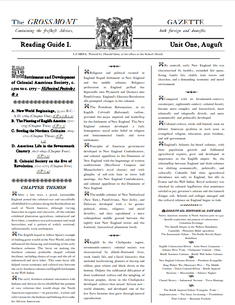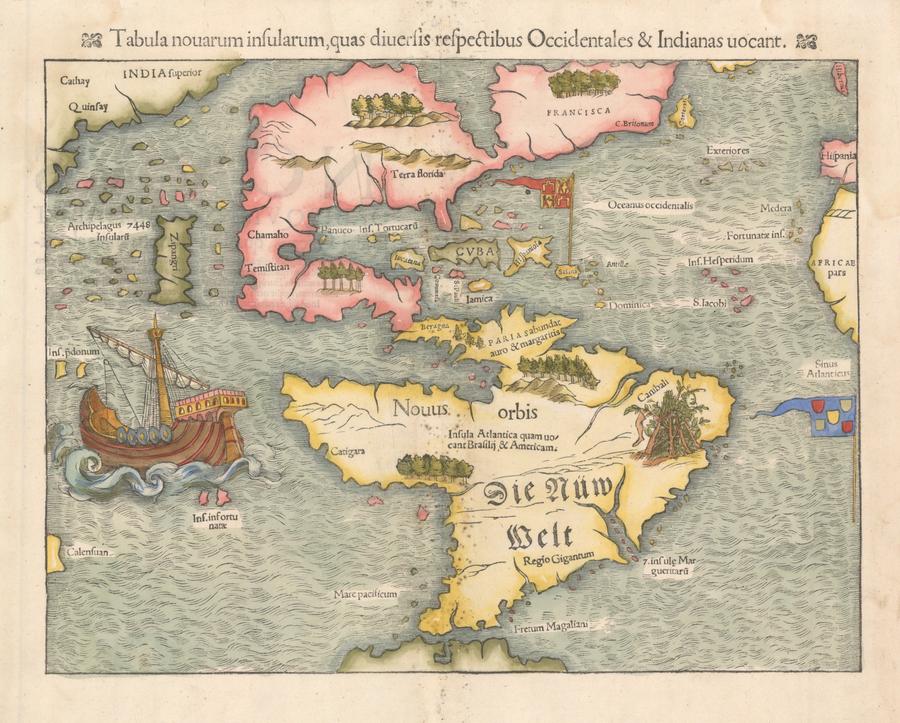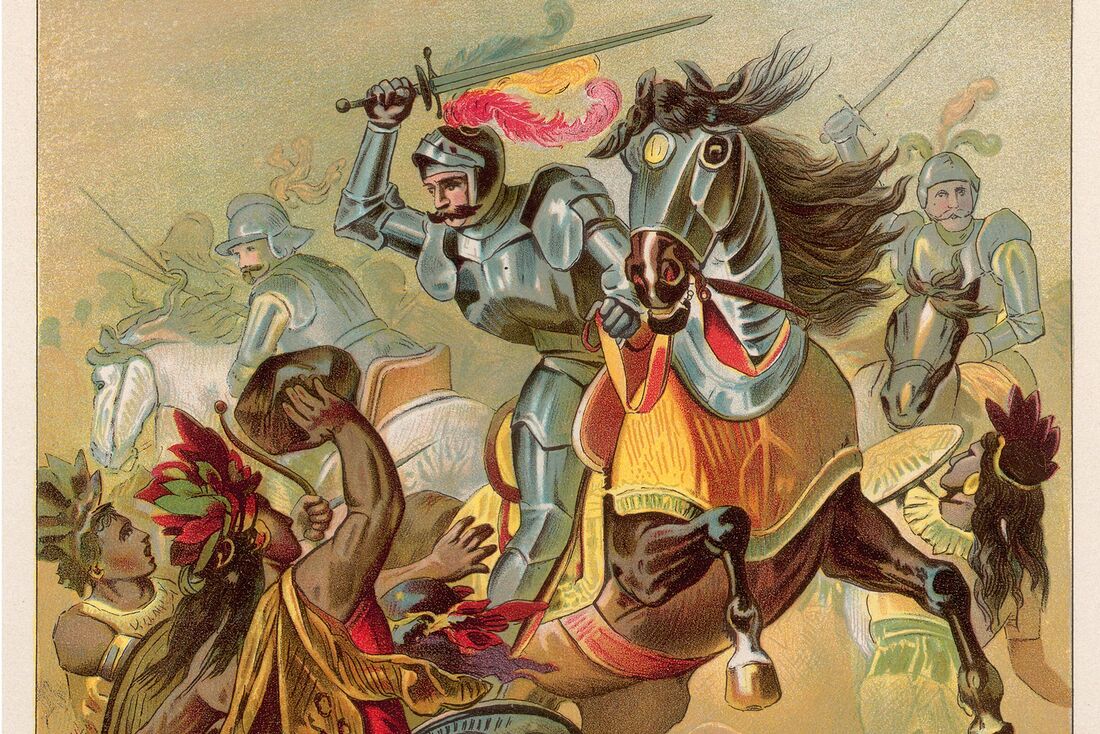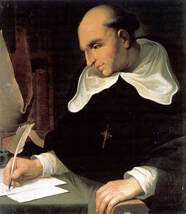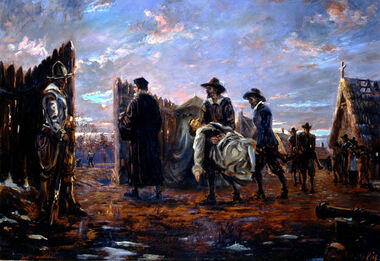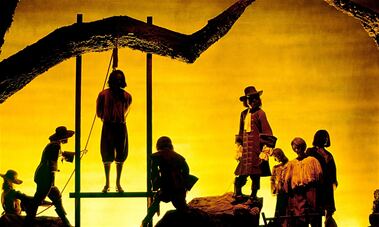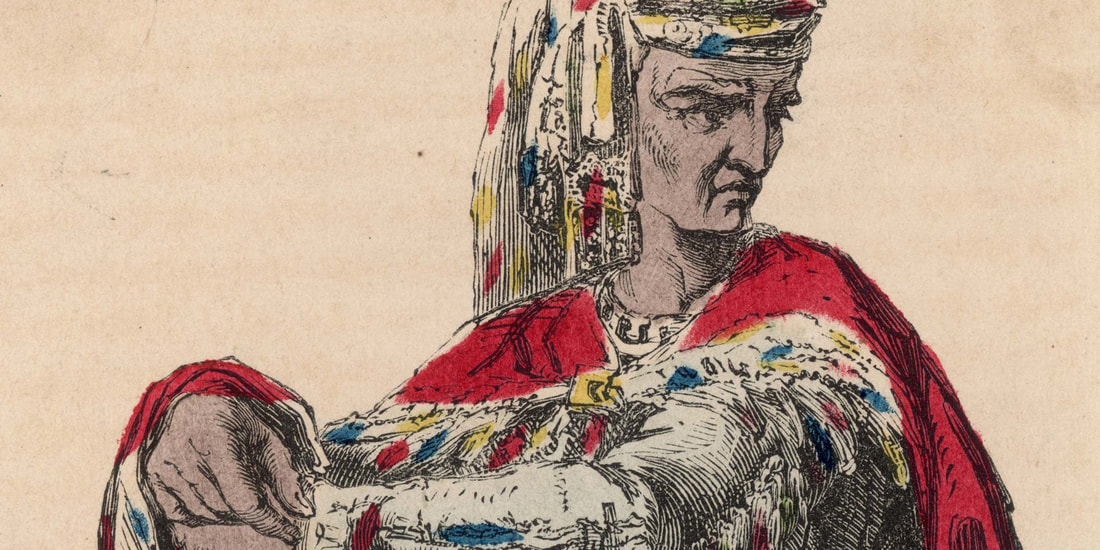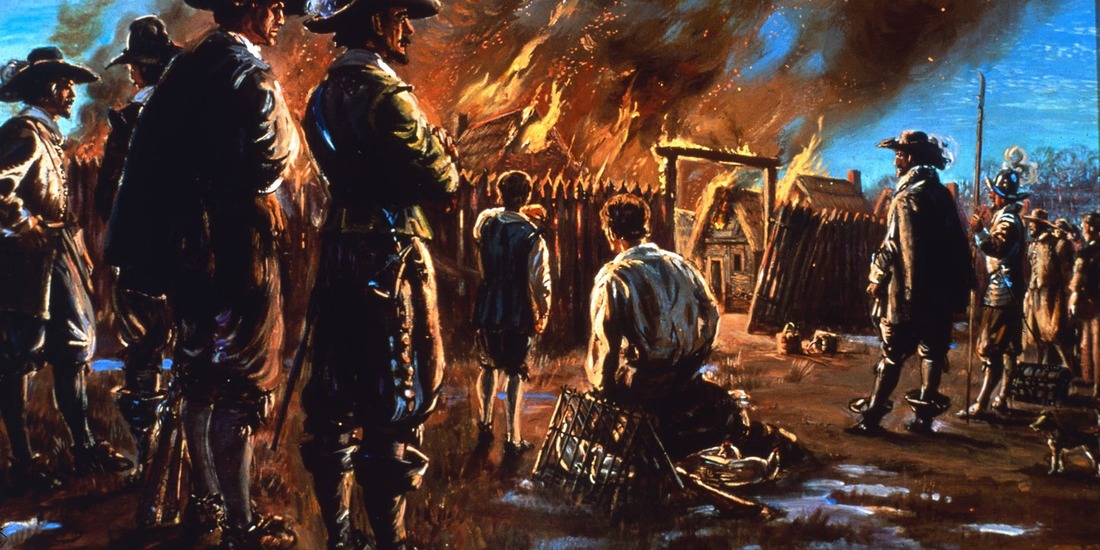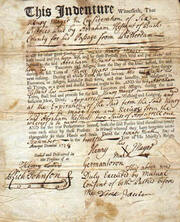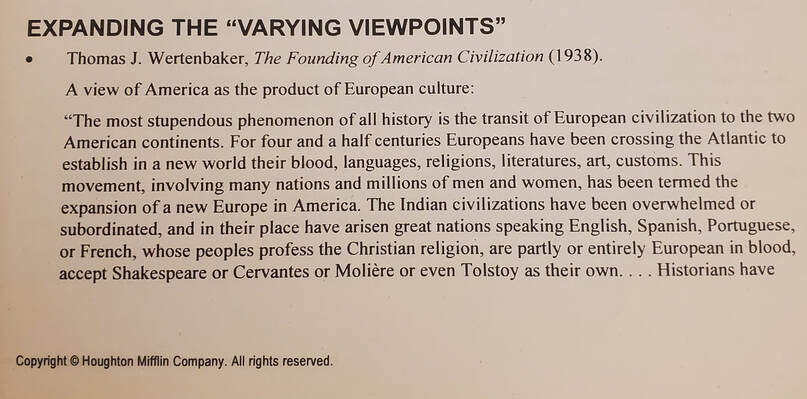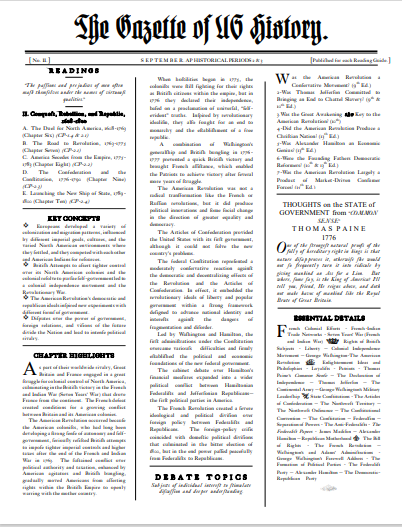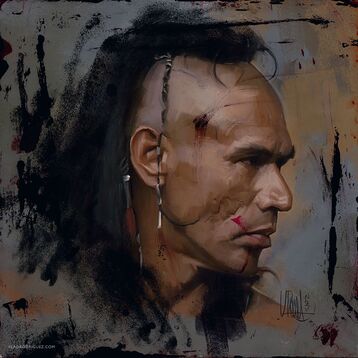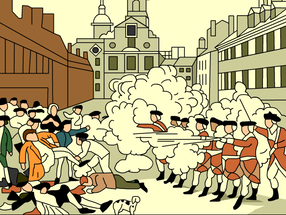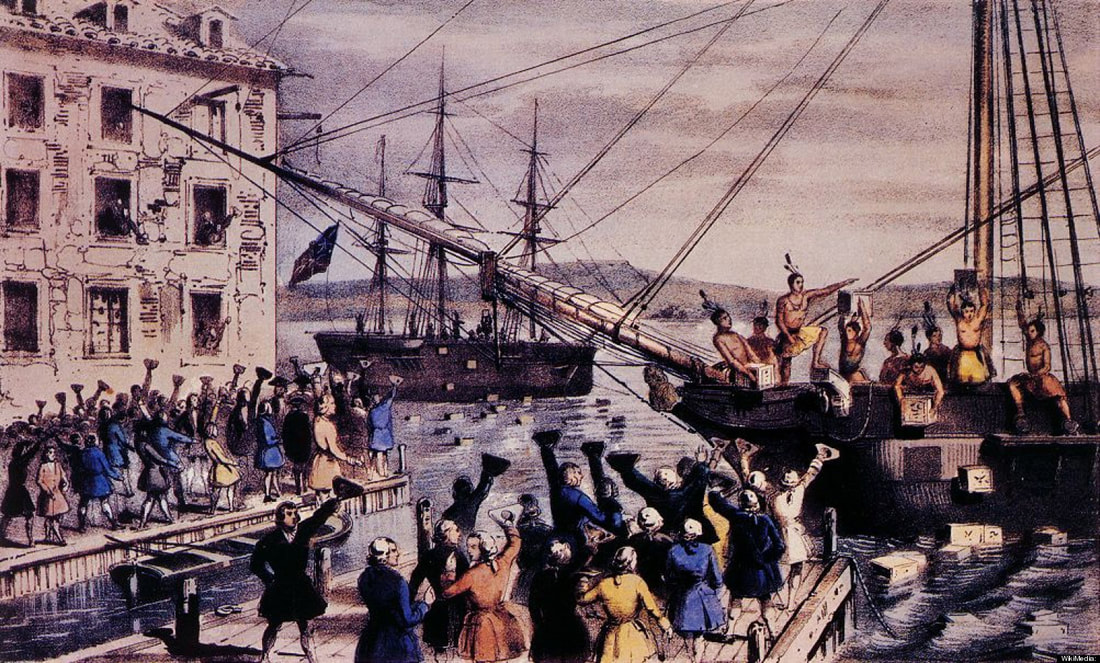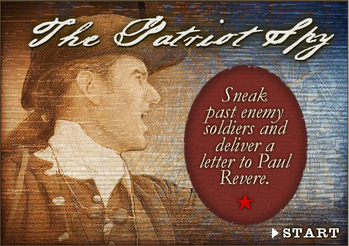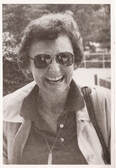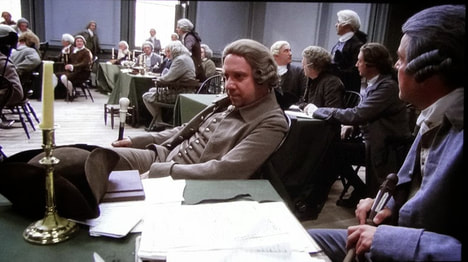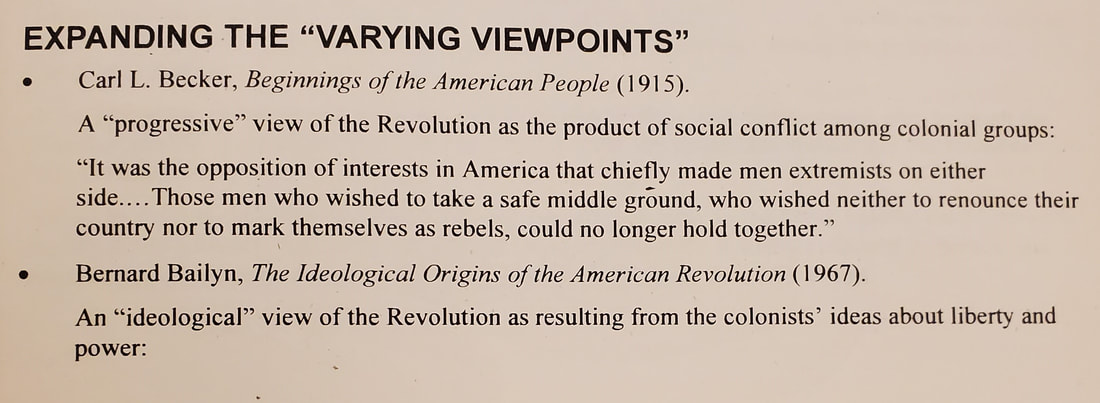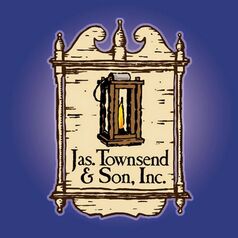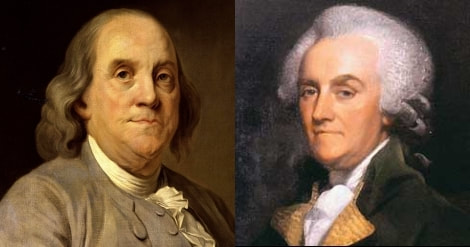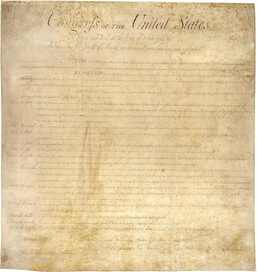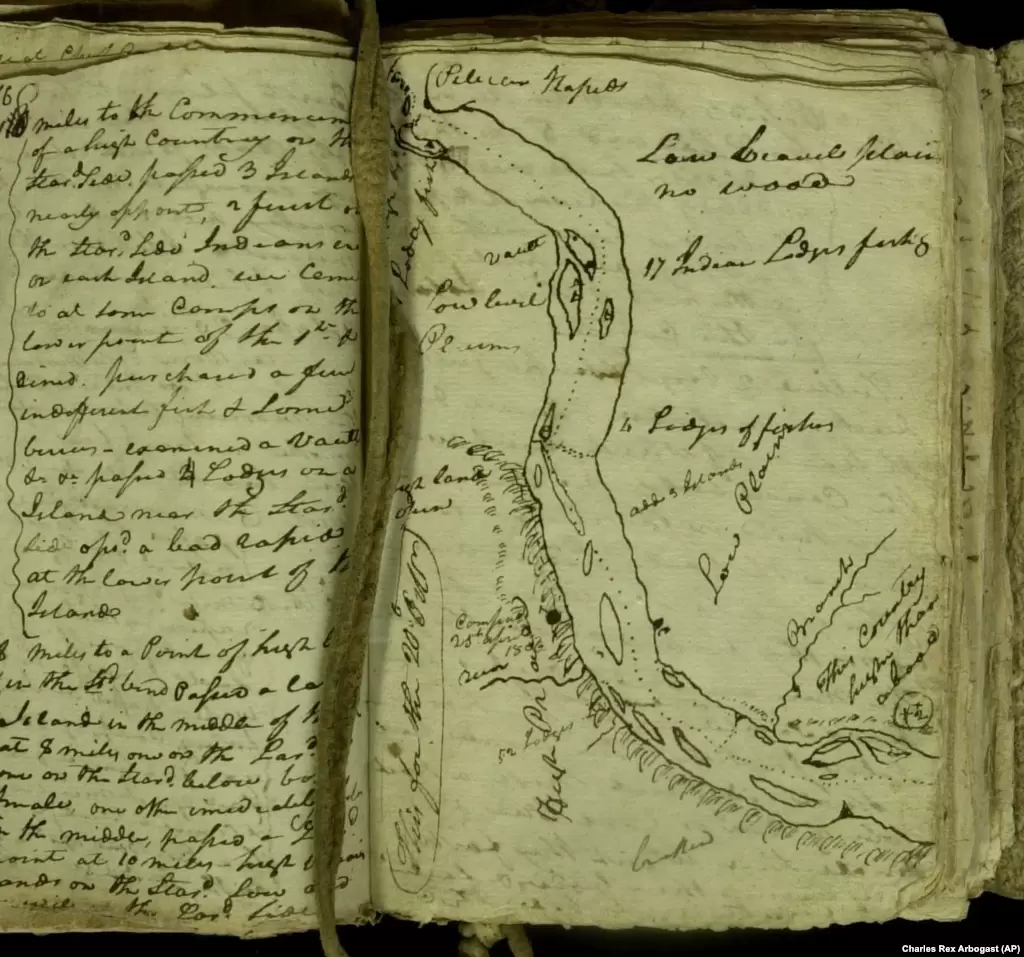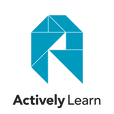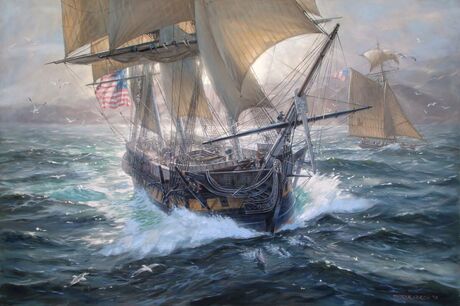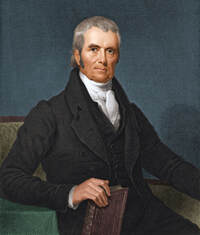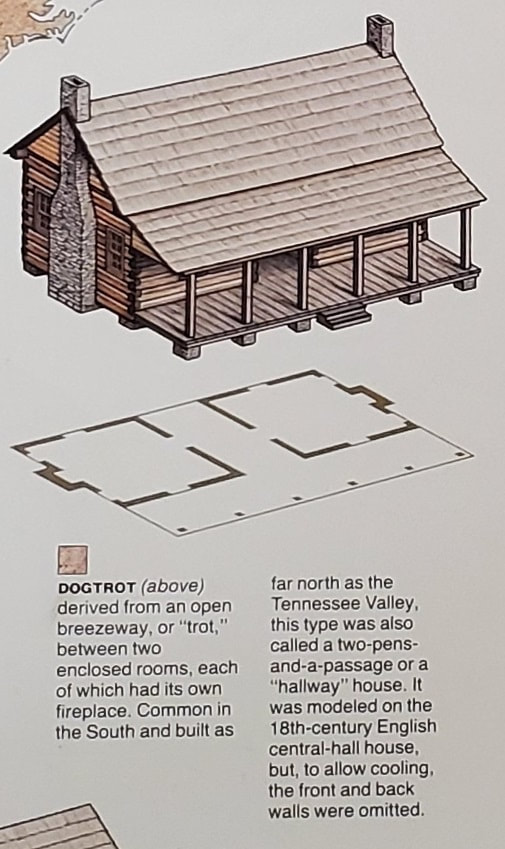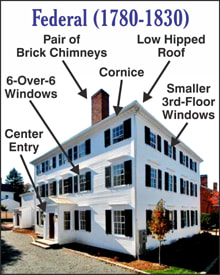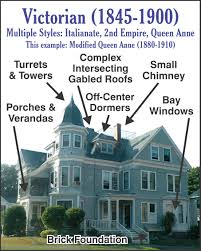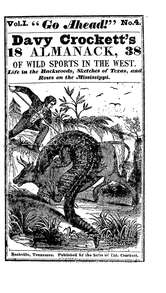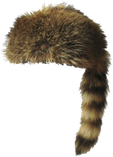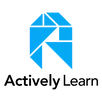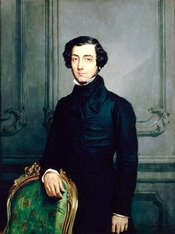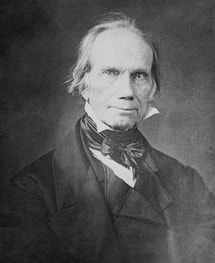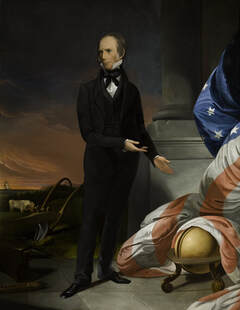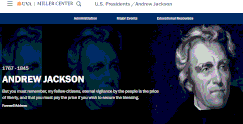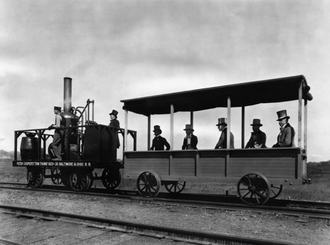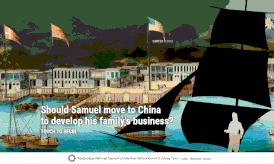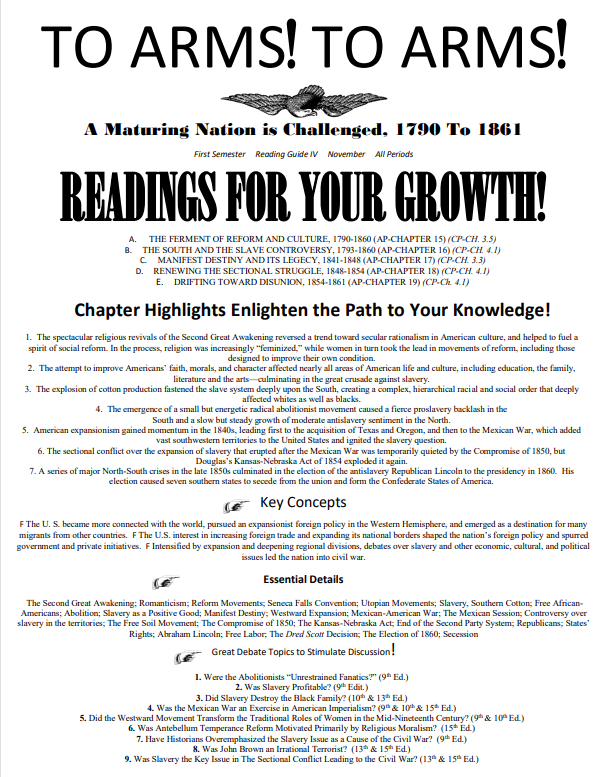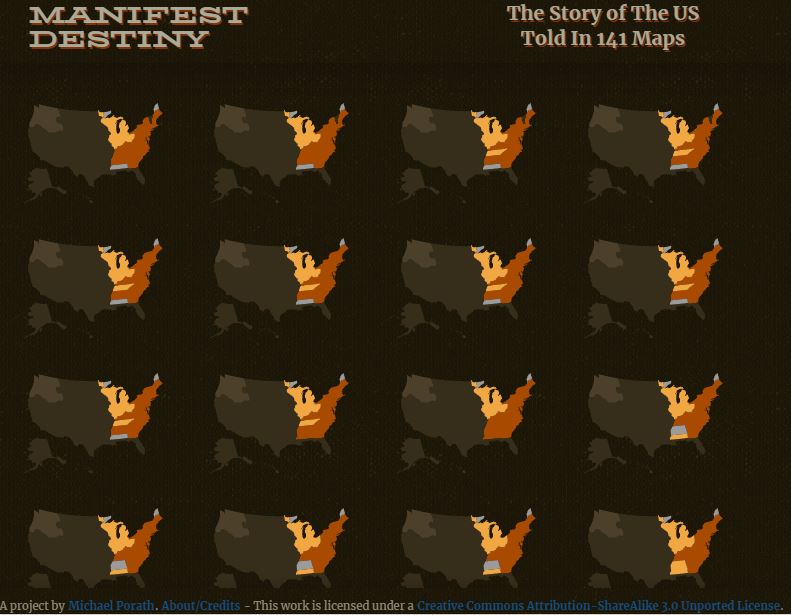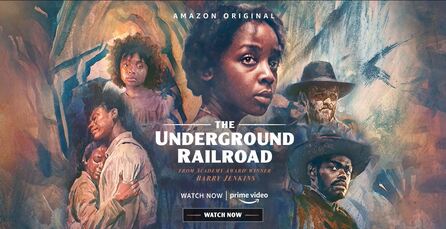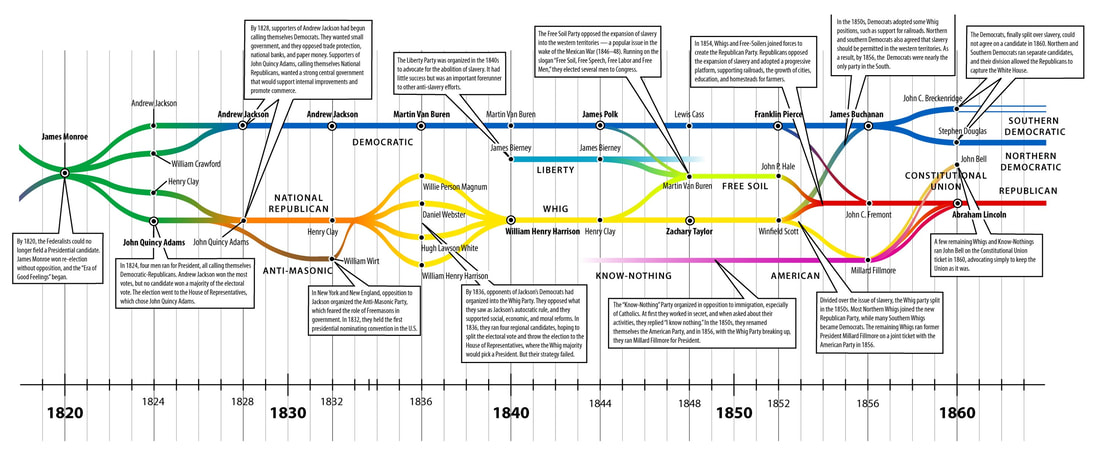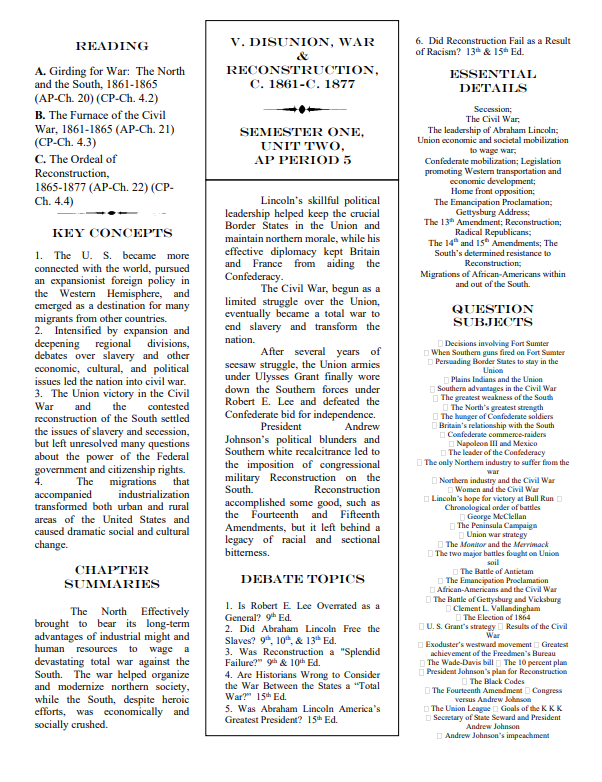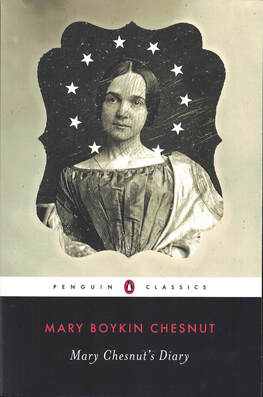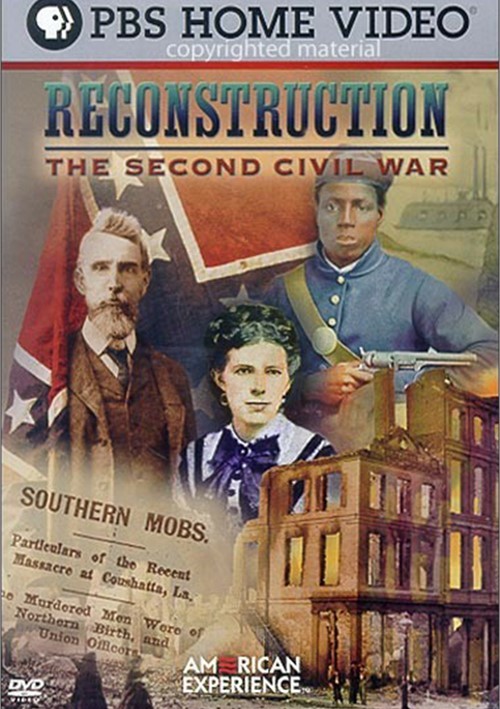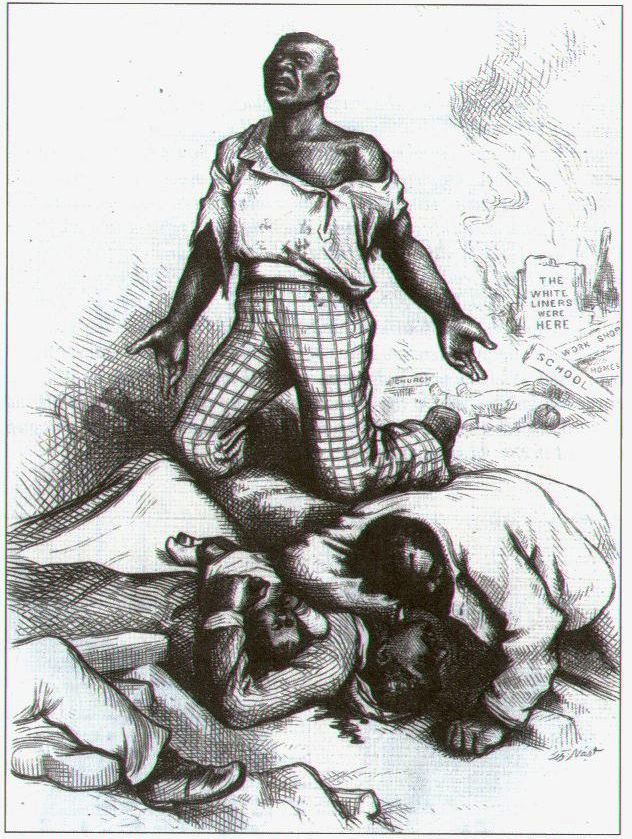READING GUIDES & LESSON LINKS
Semester One
Quick Navigation
| TS.pdf | |
| File Size: | 7098 kb |
| File Type: | |
Click the link below for great Colonial Period primary sources!
Reading Guide I
|
TIME PERIODS
|
READING GUIDE DOCUMENT
|
ESSENTIAL HISTORICAL DETAILS
|
THEMES
|
|
AP Period/Unit 1 (1491-1607)
AP Period/Unit 2 (1607-1754) |
|
| |||||||
European nations plant colonies in North America, as Native-Americans, Europeans, and captive Africans shape a New World--Three worlds collide, the results still shape our world to this day!
ADVANCED PLACEMENT CHAPTERS:
Chapter 1. New World Beginnings, 33,000 BCE-1769 CE
Chapter 2. The Planting of English America, 1500-1733
Chapter 3. Settling the Northern Colonies, 1619-1700
Chapter 4. American Life in the 17th Century, 1607-1692
Chapter 5. Colonial Society on the Eve of Revolution, 1700-1775
_
COLLEGE PREP. CHAPTERS:
Chapter 1 (1492-1754)
Chapter 1. New World Beginnings, 33,000 BCE-1769 CE
Chapter 2. The Planting of English America, 1500-1733
Chapter 3. Settling the Northern Colonies, 1619-1700
Chapter 4. American Life in the 17th Century, 1607-1692
Chapter 5. Colonial Society on the Eve of Revolution, 1700-1775
_
COLLEGE PREP. CHAPTERS:
Chapter 1 (1492-1754)
Exam Skills: Analyzing Images-1546 Map by Sabastian Munster (Pageant, p. 7)
From the Cengage Learning Teacher's Resource Guide, 2016
Click the document below.
From the Cengage Learning Teacher's Resource Guide, 2016
Click the document below.
| 20210407_133228.jpg | |
| File Size: | 423 kb |
| File Type: | jpg |
Exam Skills: Analyzing Images of "Conquistadores, ca. 1534" & "An Aztec View of Conquest, 1531" (pp. 18-19)
From the Cengage Learning Teacher's Resource Guide, 2016
Click the document below.
From the Cengage Learning Teacher's Resource Guide, 2016
Click the document below.
| 20210407_134232.jpg | |
| File Size: | 534 kb |
| File Type: | jpg |
Conflicting Spanish Views
What happened to the native peoples the Spanish encountered in the Caribbean? Click below.
The Columbian Exchange
Columbian Exchange, the largest part of a more general process of biological globalization that followed the transoceanic voyaging of the 15th and 16th centuries. Ecological provinces that had been torn apart by continental drift millions of years ago were suddenly reunited by oceanic shipping, particularly in the wake of Christopher Columbus’s voyages that began in 1492. The consequences profoundly shaped world history in the ensuing centuries, most obviously in the Americas, Europe, and Africa. The phrase “the Columbian Exchange” is taken from the title of Alfred W. Crosby’s 1972 book, which divided the exchange into three categories: diseases, animals, and plants. -Britannica.com
Guacamole!
Tasting History with Max Miller
Tasting History with Max Miller
Certainly, there were many negative consequences associated with the Columbian Exchange. One of the many positives that pleases to this day is the Avocado. Max does a great job of explaining its early history below.
Dig History!
|
Join the search for the true story of Jamestowne. Click below!
|
The New World
|
In 2005, this movie gave a glimpse into the first permanent English settlement in the North America, Jamestown. This first scene depicts the events of 14 May 1607. The Susan Constant, the Godspeed, and the Discovery are commanded by Christopher Newport (Christopher Plumber), as John Smith (Colin Farrell) escapes trouble. The history in the movie may not be entirely accurate, but the cinematography is exquisite. I wish this scene upload had included the first contact with the Powhatans, which comes next in the movie! So typically, Pocahontas is portrayed as a young woman and not the child Smith described.
|
|
"Screening History"
|
You are one of the treasures of these United States, beloved friend.
|
PBS-Scientific American Frontier's
Alan Alda takes us on an historic journey to "Unearth Secret America" |
Here, we discover the truth about English colonial difficulties, the historical value of sub-floor pits, the power of historic portrayal, and the "Peculiar Institution's" impact on Thomas Jefferson and the people who lived on his plantation.
Jamestown Cannibalism!
Colonial Failures
Hey, it is not just England that had trouble starting colonies in the New World! Study this National Geographic map below to see the universal troubles.
New England
|
There seems to be some confusion over the difference between a Pilgrim and a Puritan!
|
|
Colonial House
What must it have been like to live in 1628 as a colonist in the New World? Check out what happened when the BBC experimented with having people experience 17th century life in New England! Can modern people deal with the basics of life in the past? Click below to find out.
The Puritans were the biggest factor in establishing New England, but we Americans focus on the first small group of English in the area, the Separatists known as the Pilgrims. They didn't want to purify the Church of England, they wanted separation. Their very Christian and common thanks for the grace of God eventually becomes a holiday. Enjoy the website. Click the button below.
Actively Learn: The Complicated Legacy of the Pilgrims
The Puritan Mission
|
Johnathan Winthrop's "A Model of Christian Charity" (1630) "From the beginning, ministers like Robert Cushman and civil magistrates like William Bradford and John Winthrop urged their citizens to recognize that they were drawn together for a [unique and special] purpose far beyond their own liberty, or even security, and to place the welfare of the community as a whole above their own." How might this motivation have led to the success of the Puritan colony? |
Exam Skills: Document Analysis-"An Indian Massacre of 1622" in de Bry's America, 1628.
From the Cengage Learning Teacher's Resource Guide, 2016
From the Cengage Learning Teacher's Resource Guide, 2016
a) Briefly explain the point of view expressed by the artist about ONE of the following:American Indians
British Colonists
Colonial Warfare
b) Briefly explain ONE development from the period 1492 to 1628 that led to the point of view expressed by the artist.
c) Briefly explain ONE way in which the period from 1628 to 1754 challenged or supported the point of view expressed by the artist.
British Colonists
Colonial Warfare
b) Briefly explain ONE development from the period 1492 to 1628 that led to the point of view expressed by the artist.
c) Briefly explain ONE way in which the period from 1628 to 1754 challenged or supported the point of view expressed by the artist.
Salem Witchcraft
|
"Few events in American history are better known than the Salem witchcraft trials of 1692. Their popularity is doubtless attributable to a number of things: a persistent fascination with the occult; a perverse pleasure to expose the underbelly of an American culture that boasts of toleration, social harmony, and progress; and an appreciation for a compelling, dramatic narrative replete with heroes and villains. Skeptics, like the preeminent twentieth-century historian Perry Miller, question whether the Salem trials constituted anything more than an inconsequential episode in colonial history. But most historians consider Salem worthy of continuing investigation even if it was less than a major turning point in history." Click the botton below to explore this remarkable event. Thank you, Richard Latner and Tulane University!!
|
Doing The DBQ (1993)
"Colonial historians are virtually unanimous about the significance regional differences, which arose almost immediately along the Atlantic seaboard settlements, played in colonial development, despite their inhabitants' common English stock." Here, we compare two different ship manifests from 1635, one bound for Virginia and one for New England, to uncover some fundamental regional differences. A college Board Publication of the 1993 DBQ. Compare documents B and C below.
| docs_b_and_c.pdf | |
| File Size: | 1129 kb |
| File Type: | |
The First Period of Anglo-Indian Relations Ends
By the Late 1600s, the Defeat of Native-American resistance to English coastal settlement was determined by King Phillip's War in the New England area, and the Anglo-Powhatan Wars in the Chesapeake Bay area. Watch the NBC videos and more below.
|
|
|
|
Horrible Histories:
Charles II, "the King that brought back partying."
|
You might not learn a lot from this video about Charles Stuart or the Restoration, but it is fun! On the other hand, the BBC Movie The Power and the Passion is a wonderful portrayal of the reign of Charles the II, although there is very little coverage of the Restoration's impact on England's American colonies.
|
|
Lecture: Expanding Colonial America
|
I found a book by one of our great US Historians, Ray Billington (Occidental), from the 1960s that my Uncle used in his class at Grossmont. I expand on Billington's outline here to present one of my early lectures as a Grossmont teacher. I remember my teacher, Gloria Jones, was impressed by my own use of the book as a student. How is that for continuity and legacy!
|
|
1676!
It is hard to imagine a more significant year than 1776 in early American History, but a hundred years before this, in 1676, events took shape to change the course of English colonial development. More to come.
The Colonial Slave Trade
|
How many people were brought from Africa in the over 300 years of the slave trade? Where were these people transported to in the Americas? How did British colonial slavery change over time, say by the early 1700s? Click below.
|
Alan Alda looks into the relatively new field of slave archaeology..
Doing the DBQ (2016)
Here, we will look at the College Board's main 2016 DBQ to learn how the institution of slavery developed in the American Colonies over its first 100 years. We focus on documents 3 and 4, below. The "Peculiar Institution" was defined by the turn of the 18th Century!
|
“White Servitude”
In his seminal work, historian Richard Hofstadter explores American society and indentured servitude at 1750. Below, an exerpt from Eyewitness and Others: Readings in American History, Volume 1.
| |||||||
William Byrd II's Secret Diary
"The Black Swan of Westover," "Colonel" Byrd
|
"What follows are selected entries from the diary of William Byrd, a gentleman from Virginia who is representative of the southern landed aristocracy. Byrd's diary was kept in a secret shorthand and discovered only in the twentieth century. It provides insight into the mind of a southern gentleman. Byrd's diary also lets us see the daily schedule and the thoughts of a gentleman. Byrd committed to his diary some of his most private thoughts and actions." Click below.
From the National Humanities Center Resource Toolbox |
The Source of Virginia Colony's Wealth: Tobacco
|
Tobacco growing was essential Virginia. Justin Filipowski from George Washington's Mount Vernon sits down with Jon Townsend to talk about the tobacco trade in early America.
|
|
Colonial Society and Dress
|
Click below to discover Colonial American life on the Colonial Williamsburg Site! Manners and clothes maketh the colonist! Investigate what items of clothing were part of everyday life by clicking on "Dressing the Part," below.
|
Dressing the Part for Real
The videos below do a great job of showing the 18th century dress of Ladies and Gentlemen, also middling women.
|
|
|
|
|
|
|
"We wore what we wore."
This is a great article by Ink Mendelsohn about the impact of class on clothing in our history. Click on the header to learn more.
|
What is happening in New
England?
England?
|
There is a mystery afoot! Big changes are occuring in New England, as the region leaves the 17th century and enters the 18th. Can you use the clues to determine what is happening? Read the document clues provided, try and link this evidence, and explain the changes you see taking place. Click below to explore the changes occuring in New England and Boston as the 17th century turns to the 18th.
|
|
Historian James A. Henretta, Professor Emeritus of American History at the University of Maryland, provides New England data from The Evolution of American Society, 1700-1815: An Interdisciplinary Approach. Also, Professor Gary Nash, of UCLA, contributes Boston data from Urban Wealth and Poverty in Pre-Revolutionary America.
|
Taken from Discovering the American Past: A Look at the Evidence, "The Rhythms of Colonial Life."
|
Lecture: Life and Thought in
Colonial America
Colonial America
Once upon a time Americans . . .
Adapted from Eric Sloan's Dover Publication book of the same name.
were frugal. When other nations conquered for gold and riches, Americans were content to seek and work for what they needed to survive. Few today are content to satisfy only basic needs.
had a reverence for wood. Trees were essential for all tools, for cooking and food, for housing and warmth, for all livelihood. Today trees are not given the same respect as they once were. People today don't even realize that most of our energy comes from their fossilized remains.
enjoyed hard work. Hard work was a necessary and unavoidable aspect of survival. It was also considered its own reward, as important accomplishments were celebrated and appreciated by all, giving pride and joy. Today, hard work is something avoided by the majority of people.
found joy at home. Home was everything: It was where you were born and raised; where you lived and worked; where you found joy and entertainment; where skills were learned. Today, many aspects of life occur outside the home, sometimes very far away.
were close to nature. Nature was close and understood, even by children. Today, even with science all around, people do not look up to even see nature, let alone understand the phases of the Sun and Moon or their importance to life.
were more faithful. Religion was central to life. Free time and money were frequently spent in reverence to God. The Bible was the first book used to teach reading and to instruct in morality. Today, there is much less time and reverence given to God and religion.
had a reverence for wood. Trees were essential for all tools, for cooking and food, for housing and warmth, for all livelihood. Today trees are not given the same respect as they once were. People today don't even realize that most of our energy comes from their fossilized remains.
enjoyed hard work. Hard work was a necessary and unavoidable aspect of survival. It was also considered its own reward, as important accomplishments were celebrated and appreciated by all, giving pride and joy. Today, hard work is something avoided by the majority of people.
found joy at home. Home was everything: It was where you were born and raised; where you lived and worked; where you found joy and entertainment; where skills were learned. Today, many aspects of life occur outside the home, sometimes very far away.
were close to nature. Nature was close and understood, even by children. Today, even with science all around, people do not look up to even see nature, let alone understand the phases of the Sun and Moon or their importance to life.
were more faithful. Religion was central to life. Free time and money were frequently spent in reverence to God. The Bible was the first book used to teach reading and to instruct in morality. Today, there is much less time and reverence given to God and religion.
" Let the Logs Speak to You . . ."
|
Log Homes of the Early American Frontier -- Investigating and Re-building. Talking to reenactor and builder, Ronnie Dowdy.
|
|
Expanding the "Varying Viewpoints"
Reading Guide II
|
TIME PERIODS
AP Period/Unit 2 (1607-1754)
AP Period/Unit 3 (1754-1800) |
READING GUIDE DOCUMENT
| |||||||
In Reading Guide I, we discovered how England's North American Colonials were distinct and unique by the 18th century--we have studied the long-term conditions that could make revolution possible and will now discover the events that determined when that revolution took place!
CHAPTERS
Chapter 6. The Duel for North America, 1608-1763
Chapter 7. The Road to Revolution, 1763-1775
Chapter 8. America Secedes from the Empire, 1775-1778
Chapter 9. The Confederation and the Constitution, 1776-1790
Chapter 10. Launching the New Ship of State, 1789-1800
_
CP Chapters 1 & 2
Chapter 6. The Duel for North America, 1608-1763
Chapter 7. The Road to Revolution, 1763-1775
Chapter 8. America Secedes from the Empire, 1775-1778
Chapter 9. The Confederation and the Constitution, 1776-1790
Chapter 10. Launching the New Ship of State, 1789-1800
_
CP Chapters 1 & 2
The French and Indian War-Site Down
|
"Watch 300 years of Colonial Expansion develop in North America as Spain, France, England and Holland explore, claim, and settle vast territories. Eventually British and French interests collide in the French and Indian War. French and British colonial ambitions collide in 1753 as 21-year-old Major George Washington accidentally ignites the French and Indian War. The War is but one component of the worldwide Seven Years War, but the war will determine the future of North America and set the stage for both the American Revolution and the French Revolution. The animation offers more detailed coverage George Washington’s fight at Fort Necessity, Braddock’s disastrous expedition of 1754, and the fabled Battle of the Plains of Abraham in 1759." Click below to see the war unfold before your eyes! This site is gone! We shall see if it returns. This is a great loss if it does not.
| |||||||
The Last of the Mohicans: A Narrative of 1757 (1826)
|
Lecture: The Road to Revolution
|
|
The Sons of Liberty and the Committees of Correspondence.
|
What was the importance of these groups, and how did they impact Colonial resistance to British tax policy? Click below to find out!
|
Boston, 1770
|
Benjamin Franklin compared sending English soldiers to Boston to setting up a blacksmith's forge in a room full of gunpowder. In the winter of 1770 an incident that seemed destined occured between soldiers and civilians, galvanizing colonial resistance to British colonial policy. From HBO's John Adams series.
|
|
The "Party"
|
What really happened that winter night in Boston harbor, 1773? Click below to have all your questions answered.
|
The Patriot Spy
|
Just a bit of fun, Boston, 1775. Can you slip past Loyalists and English soldiers to deliver a message to Paul Revere? The message is to warn Samuel Adams and John Hancock, leaders of The Sons of Liberty in Lexington, of their imminent arrest! Click below to try on this National Park Service page. WebRangers activities were retired at the end of 2019. Another loss.
|
April Morning
|
April Morning is a novel by Adam Cooper about a young man shaped by the events of April 19, 1775. A film version was made for television starring Chad Lowe as Adam and Tommy Lee Jones as Moses, and is one of the few cinematic attempts to portray the events at Lexington Green, however accurate or inaccurate they may be. I saw this in Gloria Jones' US History class at Grossmont a lifetime ago (in 1985). Enjoy.
|
Gloria and I met up again, after I took over her APUSH class in 2000, in San Antonio to grade AP essays--what a great way to show her how much she inspired me to take on more. From there, she and the "Old Guard" went to Louisville to grade for a year, leaving grading after realizing that grading had changed forever. I was a proud grader and table leader for many years, always honoring this great lady. I left grading when Tampa became our new home, but still remember Gloria and the friends I enjoyed for those several days a year, every year.
|
Brandon Fisichella, at Nativeoak.com, checks the historical accuracy below.
|
Colonial Unity?
Peek into the Pennsylvania State House (soon to be "Independence Hall") meeting of the Second Continental Congress, after the fighting has already occured at Lexington and Concord in the Spring. How close do you think they are to declaring independence? From HBO's John Adams series.
|
King George's response to the peace petition (The Olive Branch Petition).
|
|
Patrick Henry's "Give me liberty or give me death" speech.
|
One of the most famous and celebrated speeches in American History. Click below to understand the emotional appeal that helped shape the discussion toward independence.
|
|
The Importance of Thomas Paine's Common Senese
|
Expanding the "Varying Viewpoints"
Declaring Independence and Setting the
Course of US History
Morgan Freeman visits the American Philosophic Society to learn about the Declaration of Independence, and the meaning of "inherent rights." He also hosts a celebrity reading of the document.
The American Revolution Animated
HistoryAnimated.com provides an interesting and unique look at the American Revolution. "If a picture is worth a thousand words, a good animation is worth ten thousand. After reading book after book about . . . war and finding only complicated maps with dotted lines and dashed lines crisscrossing the pages, we decided to depict the key naval and land battles using animation technology." Click below to see the conflict unfold! This site is gone for the moment. Tragedy!
The Conway Cabal
|
If you thought everyone loved General Washington you are wrong! By the end of 1776, there were a growing number of influential people in Congress and in the Army that had doubts about Washington's ability to command. At this point in the War there had been only defeat, and everyone was in a desperate mood. Whether it was part of a plot (conspiracy or cabal) or not, a letter criticizing Washington is sent from Thomas Conway to General Horatio Gates--Washington learns of this letter, and other talk, promting him to inform Congress that, if they have any doubts, he would resign his command. This threat to leave ended any serious attempts to replace Washington as head of the Continental Army. In this scene from "The Crossing," Gates (Nigel Bennett) visits Washington (Jeff Daniels) days before the famous Crossing of the Delaware River. Enjoy.
|
|
What did a soldier eat?
Exam Skills: SAQ (Short Answer Question)-Two Interpretations of the Revolution
From the Cengage Learning Teacher's Resource Guide, 2016
From the Cengage Learning Teacher's Resource Guide, 2016
"Expanding Varying Viewpoint-"The Constitution: Revolutionary or Counterrevolutionary" (pp. 180)" Open the document below.
| the_american_revolution.pdf | |
| File Size: | 408 kb |
| File Type: | |
Expanding the "Varying Viewpoints"
A House Divided
The relationship between Patriot father Ben Franklin and Loyalist son William symbolized the division that existed between Americans in the American Revolution. It wasn't just the Civil War that divided families! Watch the Nation Archive speech with author Daniel Mark Epstein.
|
LIBERTY!
This is a great series perfectly constructed in teachable segments and episodes. It is a must for teachers. "The American Revolution is a dramatic documentary about the birth of the American Republic and the struggle of a loosely connected group of states to become a nation. The George Foster Peabody award-winning series brings the people, events and ideas of the revolution to life through military reenactments and dramatic recreations performed by a distinguished cast. Click on the button below to learn more." |
Was Our Revolution Revolutionary?
Many look at the American Revolution as far less significant than other revolutions. Why is our Revolution given less respect? Here are some of the most respected historians on the issue:
1. The Radicalism of the American Revolution (edited), by Gordon S. Wood, 1992.
2. The American Revolution Considered as a Social Movement (edited), by J. Franklin Jameson, 1926.
3. A People's History of the United States (chapter 5) , by Howard Zinn, 1980.
4. Progressive Historiography of the American War for Independence, by Author Mike Crane
Click below to compare the opinions of these historians.
We are a nation founded on ideas represented by three documents: The Declaration of Independence, the Constitution, and the Bill of Rights, defining our Nation's mission. Better said, we are the first nation founded on Enlightenment ideas, proving the validity of those ideas to this day--that ordinary people can create a government to protect their, and every American's God-given rights.
The Articles of Confederation
|
Was America's first constitution a total disaster? Together, with the spreadsheet below, we will weigh the good and bad.
| |||||||
|
The Constitution & Compromise
The Constitution was a series of compromises meant to ease fears of too strong or too weak a government. Can you identify the atributes of the Constitution meant to ease those fears? Click below to use the Constitution worksheet and the Constitution itself to complete the assignment. |
|
Having Fun with the link below!
| ||||||
Jib Jab
A moment for a bit of fun . . .
The Beginning of Political Parties
|
Peek behind the governing curtain to see divisive faction develop in Washington's cabinet. Thomas Jefferson (Stephen Dillane-Stannis Baratheon) questions Alexander Hamilton (Rufus Sewell) on his financial measures. From HBO's John Adams series
|
|
Did Washington Have An Accent?
|
President Washington was from Virginia. Would he have sounded like a wealthy Southerner, or would he have sounded like he was English? Probably, he would have sounded somewhere in between, as culture, geography, and numerous other factors would have changed the language he spoke from that of his parents, grandparents, and great grandparents (the first to live in Virginia). You probably don't sound like your grandparents either.
Today, mass media is changing the dynamics of our language and creating a neutral type of unaccented speech, while in some areas our language is getting more complex. Watch the videos here to learn some of the historic complexities of our speech. |
Dialect Coach, Erik Singer's Tour of North American Dialects
How did the other Presidents, during the period of recorded sound, sound?
|
|
Be Washington: Do you have what it takes to lead like George Washington?
Be Washington is a first-person interactive leadership experience. Come face to face with challenges that George Washington confronted as commander in chief or president in four key scenarios. Host a game and control the pace of individuals, or play as a single player. This game is COPPA compliant. |
Washington's Farewell Address
|
What advice did President Washington have for the future United States? Click below!
|
|
Lecture:
The Federalist Period |
|
Are you a Federalist
Take the test, answering yes or no to the questions, to find the Faction to which you would have belonged! Watch the video at right.
|
|
What happens when the friendship of two founding fathers is tested by politics and partisanship? In the this CommonLit lesson we will explore this topic and the relationship between John Adams and Thomas Jefferson by researching and using evidence.
Period 5-QBWPNGP
Period 4-9RDK7L3
Period 1-E5Q4J5V
Period 6-ZB4WL3Q
Period 3-E5Q9LZ7
Period 4-9RDK7L3
Period 1-E5Q4J5V
Period 6-ZB4WL3Q
Period 3-E5Q9LZ7
What would attack ads have looked like in 1800?
|
Very funny!
|
|
Expanding the "Varying Viewpoints"
POLITICAL TIMELINE
From www.learnnc.org
From www.learnnc.org
| POLITICAL TIMELINE ONE.jpg | |
| File Size: | 361 kb |
| File Type: | jpg |
Reading Guide III
|
TIME PERIODS
AP Period/Unit 4 (1800-1848)
AP Period/Unit 5 (1844-1877) |
| ||||||||||
A political revolution changes the leadership of our country, as Jefferson's philosophies shape the era. America expands and grows but must still navigate the dangerous waters that keep it in the middle of European politics and the rise of Napoleon and French drama. Ultimately, economic growth and American concepts of equality put the Nation on a treacherous yet destined course to confront its founding principles.
CHAPTERS
Chapter 11. The Triumphs and Travails of the Jeffersonian Republic, 1800-1812
Chapter 12. The Second War for Independence and the Upsurge of Nationalism, 1812-1824
Chapter 13. The Rise of Mass Democracy, 1824-1840
Chapter 14. Forging the National Economy, 1790-1860
_
CP Chapter 3
Chapter 11. The Triumphs and Travails of the Jeffersonian Republic, 1800-1812
Chapter 12. The Second War for Independence and the Upsurge of Nationalism, 1812-1824
Chapter 13. The Rise of Mass Democracy, 1824-1840
Chapter 14. Forging the National Economy, 1790-1860
_
CP Chapter 3
The Jefferson Presidency
|
Who were the Democratic-Republicans and what did they believe? The two Activily Learn assignments below will desribe Thomas Jefferson's party and philosophy.
Click your Period's Button to complete this Actively Learn Assignment.
|
The Corps of Discovery;
the Journey of Lewis and Clark
the Journey of Lewis and Clark
Exploring the Louisiana Territory:
"When Thomas Jefferson dispatched Lewis and Clark to find a water route across North America and explore the uncharted West, he expected they'd encounter woolly mammoths, erupting volcanoes, and a mountain of pure salt. What they found was no less surprising. Click on the buttons below to learn more!
"When Thomas Jefferson dispatched Lewis and Clark to find a water route across North America and explore the uncharted West, he expected they'd encounter woolly mammoths, erupting volcanoes, and a mountain of pure salt. What they found was no less surprising. Click on the buttons below to learn more!
|
Public Broadcasting has a beautiful site activity that incorporates the famous 1997 Ken Burns documentary. Click on the PBS button below.
OTHER RESOURCES
|
. . . . . . . . . . . . . . . . . . . . . . . . . . . . . . . . . . . . . . . . . |
An amazing site from the Missouri Historical Society.
FLASH REQUIRED
| ||||||||||||
The War of 1812 in the Chesapeake
Much of the War of 1812's pivital events took place in the Great Lakes region, while the War's most memorable battle occured at New Orleans, after a treaty to end the War was already signed. Here, we will look at the battles that saw the Capital burned and inspired a poem that became our Nation's anthem.
Much of the War of 1812's pivital events took place in the Great Lakes region, while the War's most memorable battle occured at New Orleans, after a treaty to end the War was already signed. Here, we will look at the battles that saw the Capital burned and inspired a poem that became our Nation's anthem.
America's Ship: The U.S.S. Constitution.
|
No ship has served her country as long or gloriously. Check out the Museum's website below. Also, see if you can match my score in the simulation (Click the button link below.)
|
|
Exam Skills: SAQ (Short Answer Question)-"The Present State of Our Country?" (Political Cartoon, p. 223)
From the Cengage Learning Teacher's Resource Guide, 2016 Could you answer the questions below? a) Briefly explain the point of view expressed by the political cartoonist about ONE of the following: -The Federalist Party -The Democrat-Republican Party -George Washington b) Briefly explain ONE development from 1789 to 1809 that may have led to the point of view expressed by the cartoonist. c)Briefly explain ONE way in which the developments from 1789 to 1808 challenged the point of view expressed by the cartoonist. |
Doing the DBQ: Federalist and Republican Hypocracy
1998's Document-Based Question has us look at evidence suggesting that our Nation's first two political parties were not above political expediency. Below, included with all College Board DBQs from 1973 to 1999, is 1998's. Scroll down to page 175.
| ap_ush_dbq_73-99.pdf | |
| File Size: | 33777 kb |
| File Type: | |
John Marshall's Court
|
"John Marshall became the fourth chief justice of the U.S. Supreme Court in 1801. He is largely responsible for establishing the Supreme Court's role in federal government. Chief Justice John Marshall was born on September 24, 1755, near Germantown, Virginia. In 1780, Marshall started his own law practice, defending clients against pre-war British creditors. From 1782 to 1795, he held various political offices, including the position of secretary of state in 1800. In 1801, he became chief justice of the U.S. Supreme Court, serving until his death, on July 6, 1835, in Philadelphia, Pennsylvania." We will discover how Marshall increased the power of the Court and the Federal Government using the worsheet below.
|
| marshalls_court_decisions.pdf | |
| File Size: | 84 kb |
| File Type: | |
|
Lecture: The Era of
Good Feeling |
|
Exam Skills: SAQ (Short Answer Question)-"We Owe Allegiance to no Crown" (Painting, p. 234)
|
Could you answer the questions below?
a) Briefly explain the point of view expressed by the artist about ONE of the following: -New World (American) Political Institutions -Old World (European) Political Institutions -American National Culture b) Briefly explain ONE development from 1800 to 1820 that may have led to the point of view expressed by the artist. c)Briefly explain ONE way in which the developments from 1800 to 1820 challenged the point of view expressed by the artist. |
| nationalism_saq.pdf | |
| File Size: | 78 kb |
| File Type: | |
Westward Ho!
Early American Housing from the Historical Atlas of the United States
Other Main Architecture Styles
Davy Crockett, King of the Wild Frontier
There is no life that better represents the spirit of a young and growing nation than that of Davy Crockett. Here, we will began to understand just how important this man's life and legacy has become to our story, through a Biography episode about the life of a living legend.
|
In the mid-1950s, Walt Disney created a series of movies celebrating the Frontier hero Davy Crockett (portrayed by Fess Parker). The success of movies led to Disneyland's inclusion of elements from the Crockett story to Frontierland and the Rivers of America. As the popularity of Crockett spread, the nation's youth adopted his story to make the image of Davy a permanent part of our culture--at least one high school made his image their mascot!!!
|
|
|
|
Billy Bob Thorton portrays Davy Crockett's last moments in 2004's The Alamo. Not entirely accurate, but interesting--you can't outlive your legend!
|
On Democracy in America
|
De La Démocratie en Amérique
Alexis de Tocqueville's great work was published in two volumes, the first in 1835 and the second in 1840. Its title translates as On Democracy in America. While investigating America's prison system for France, Tocqueville writes his observations of the new American Republic. The following excerpts explore the relationship between the American "love of money" and the commitment to "democracy" and "equality." Also described is the incredible "restlessness" of Americans in the pursuit of "happiness." These observations about our early Republic highlight truly unique American characteristics. Click below. |
Clay's American System
One of the greatest statesman American has yet produced, Henry Clay had a vision and political platform to unify and enrich the United States. Only partially adopted, as growing sectionalism presented insurmountable obstacles, Clay's American System none-the-less envisioned posibilities that influenced Whig and Republican Party beliefs for generations.
The Great Compromiser
"From the birth of the American Republic in 1789, deep differences between two of its regions, North and South, coupled with westward expansion, nearly plunged the nation into civil war on three separate occasions before guns actually opened up upon Fort Sumter on April 12, 1861. Each time, one man – one statesman – forged a compromise. That man – that statesman – was Henry Clay of Kentucky. Early in his life, Henry Clay came to Kentucky and was elected to Congress. A “War Hawk,” Clay evolved into a diplomat,negotiating the Treaty of Ghent, ending the War of 1812. Clay was soon thereafter elected to the United States House of Representatives. With the petitioned statehood of Missouri in 1820, the nation faced its first crisis over whether to admit a state from the Louisiana Purchase as a free state or slave state. Speaker of the House Henry Clay defused the crisis, deemed by former president Thomas Jefferson as a “firebell in the night,” by crafting the Missouri Compromise. A second time, sectional strife flared up as the post-War of 1812 Tariff brought cries of “nullification” and even “secession” from South Carolina in the early 1830’s. After months of rising threats of civil war, Senator Henry Clay introduced the Compromise of 1833, averting disunion and bloodshed. Then, nearly twenty years later, the admission of California as a slave or free state was at stake. At no time in its history had the American Republic been brought so close to civil war, facing a situation seemingly beyond compromise. For a third time, Senator Henry Clay skillfully fashioned a compromise – the Compromise of 1850 – staving off a bloody civil war for more than a decade. Henry Clay was, indeed, the “Great Compromiser,” the “Great Pacificator.” Abraham Lincoln regarded Henry Clay as the greatest statesman the nation had ever produced, calling him “my beau ideal of a statesman.” Without question, Henry Clay’s ideals of statesmanship and compromise continue to be relevant and necessary in today’s increasingly turbulent and divided world." -HenryClay.Org
| |||||||
A Case For FreedomFew people know the story of a brave woman named Charlotte Dupuy who was enslaved by Secretary of State Henry Clay at Decatur House, the large brick residence that has stood on Lafayette Square at the corner of H Street and Jackson Place since 1818.
In 1829, while living at Decatur House, Dupuy sued Clay in the U.S. Circuit Court for the District of Columbia for her freedom. Charlotte Dupuy, or "Lotty" as she was known, felt that Clay was obligated to uphold an agreement she had with her previous owner to free her and her two children, Charles and Mary Ann, in February 1829, seventeen years before Dred Scott filed his well-known legal challenge to slavery. She believed the promise of freedom from her previous owner transferred to Henry Clay. when he purchased her in 1806, after she married Aaron Dupuy, a man already enslaved in Clay's household. |
|
Lecture: Jacksonian
Democracy |
|
Andrew Jackson
One of the most controversial figures of his age, no one could doubt his ability to lead. President Jackson saw himself as the "arm and the shield" of the common person--you decide if he lived up to his vision. Click below to visit the Hermitage, home of Andrew Jackson, or on the UVA's Miller Center site.
|
"As president, Andrew Jackson strengthened the power of the presidency, defended the Union, gained new respect for the United States in foreign affairs, and pushed the country toward democracy."
|
"Andrew Jackson, seventh President of the United States, was the dominant actor in American politics between Thomas Jefferson and Abraham Lincoln. Born to obscure parents and orphaned in youth, he was the first "self-made man" and the first westerner to reach the White House. He became a democratic symbol and founder of the Democratic Party, the country's most venerable political organization. During his two-term presidency, he expanded executive powers and transformed the President's role from chief administrator to popular tribune."
|
Another Revolution
|
"The Incredible changes taking place in America, during the period 1820-1860 (the Early Industrial Revolution), can be illustrated in a number of ways. In less than one lifetime, the number of States increased from 13 to 34, the population rose from 4 million to 13 million, and revolutions in transportation and manufacturing (the Market Revolution) transformed the lives of everyone." Here, we will use numbers to investigate these changes and practice analyzing data. Click on the document to get started.
From the Skills Approach Lessons |
| ||||||
|
The Erie Canal!
|
|
Ordinary Americans in a Rapidly Changing Country
|
The Industrial & Market Revolutions affected the entire world, but in the United States, where the nation was maturing and growing at a remarkable rate, it was even more dramatic! Discover the massive changes affecting the American people, through the simulation below.
|
The Good Old Days!
The Lady and the Mill Girl
|
Gerda Lerner had always been a contrarian, from resisting Nazis in Germany to being a Socialist Communist in 1950s America--Gerda was fearless. Her convictions and talents saw her virtually create women's history in the 1960s. Here, we read one of her seminal articles, "The Lady and the Mill Girl: Changes in the Status of Women in the Age of Jackson," published in the American Studies Journal.
| |||||||
William Sidney Mount
Mr. Mount was a truly amazing painter, capturing, at ounce, the national pride and democratic spirit of his age. Portraying everyday American life (Genre Painting), Mount celebrated the common man and helped promote the belief in basic American goodness and virtue. He also painted landscapes and portraits, like the one below. Like the Hudson River School of painting, Mount celebrated uniquely American themes.
|
"Right and Left" met with great acclaim when it appeared in 1850: "This latest fruit of the genius of the artist, of whom the country is so justly proud, we confidently predict must make a hit. It is conceived with great spirit and truth of nature.... [The fiddler] is indeed a chef d’oeuvre of Ethiopian portraiture." Mount himself played the violin and was a great lover of music. From the GODS AND FOOLISH GRANDEUR site.
|
Sectionalism
The Nation developed a strong sense of unity and nationalism after two wars. The Country also grew rapidly in size and success, but this rapid growth also highlighted regional differences. Sectionalism occurs when regions of the country put their interests ahead of the interest of the Nation as a whole.
The Nation developed a strong sense of unity and nationalism after two wars. The Country also grew rapidly in size and success, but this rapid growth also highlighted regional differences. Sectionalism occurs when regions of the country put their interests ahead of the interest of the Nation as a whole.

"A more enduring manifestation of hostility toward the nationalizing tendencies in American life was the reassertion of strong feelings of sectional loyalty. New Englanders felt threatened by the West, which drained off the ablest and most vigorous members of the labour force and also, once the railroad network was complete, produced wool and grain that undersold the products of the poor New England hill country. The West, too, developed a strong sectional feeling, blending its sense of its uniqueness, its feeling of being looked down upon as raw and uncultured, and its awareness that it was being exploited by the businessmen of the East.
The most conspicuous and distinctive section, however, was the South—an area set apart by climate, by a plantation system designed for the production of such staple crops as cotton, tobacco, and sugar, and, especially, by the persistence of slavery, which had been abolished or prohibited in all other parts of the United States. It should not be thought that all or even most white Southerners were directly involved in the section’s “peculiar institution.” Indeed, in 1850 there were only 347,525 slaveholders in a total white population of about 6,000,000 in the slave states. Half of these owned four slaves or fewer and could not be considered planters. In the entire South there were fewer than 1,800 persons who owned more than 100 slaves."
-Britannica
The most conspicuous and distinctive section, however, was the South—an area set apart by climate, by a plantation system designed for the production of such staple crops as cotton, tobacco, and sugar, and, especially, by the persistence of slavery, which had been abolished or prohibited in all other parts of the United States. It should not be thought that all or even most white Southerners were directly involved in the section’s “peculiar institution.” Indeed, in 1850 there were only 347,525 slaveholders in a total white population of about 6,000,000 in the slave states. Half of these owned four slaves or fewer and could not be considered planters. In the entire South there were fewer than 1,800 persons who owned more than 100 slaves."
-Britannica
Exam Skills: SAQ (Short Answer Question)-Jacksonian Democracy
From the Cengage Learning Teacher's Resource Guide, 2016
From the Cengage Learning Teacher's Resource Guide, 2016
"Expanding varying Viewpoints"-"What was Jacksonian democracy?" (pp. 275-276)? Click the button below.
POLITICAL TIMELINE
| POLITICAL TIMELINE TWO.png | |
| File Size: | 103 kb |
| File Type: | png |
Reading Guide IV
|
TIME PERIODS
AP Period/Unit 3 (1754-1800)
AP Period/Unit 4 (1800-1848) AP Period/Unit 5 (1844-1877) |
READING GUIDE DOCUMENT
|
THEMES
| ||||||
In this next phase of American history, the Nation is destined to expand and spread from sea to sea. But it will be "as the man swallows the arsenic"--expansion will "poison" the American union, as the issue of slavery's expansion confronts the founding principles, nearly destroying the nation.
CHAPTERS
Chapter 15. The Ferment of Reform and Culture, 1790-1860
Chapter 16. The South and the Slave Controversy, 1793-1860
Chapter 17. manifest Destiny and its Legacy, 1841-1848
Chapter 18. Renewing the Sectional Struggle, 1848-1854
Chapter 19. Drifting Toward Disunion, 1854-1861
_
CP Chapters 3 & 4
Chapter 15. The Ferment of Reform and Culture, 1790-1860
Chapter 16. The South and the Slave Controversy, 1793-1860
Chapter 17. manifest Destiny and its Legacy, 1841-1848
Chapter 18. Renewing the Sectional Struggle, 1848-1854
Chapter 19. Drifting Toward Disunion, 1854-1861
_
CP Chapters 3 & 4
Antebellum Reformers
|
Jacksonian Democracy was characterized by growing political democracy, explosive economic opportunity, and the fight to improve the social condition of the average American. We looked at the political and economic aspects of Jacksonian Democracy in the last Reading Guide. We will now explore the changing social conditions of this era, and learn how many sought to elevate the status of the average American. Click below!
|
Expanding the "Varying Viewpoints"
Jacksonian Era Reforms Outline: the Age of the Common Man and Reform
“The common man gained control of the nation’s political institutions and benefited economically from the opportunity provided by the Market and Transportation Revolutions in the early 1800s. With this power he found himself able to reshape America’s social life and thought to his own needs. Why not, he asked himself, use this new power to stamp out the last relics of aristocracy inherited from the colonial past, recasting religion in a more democratic mold, rewrite literature and produce art in terms understandable to all, launch humanitarian crusades to improve conditions, and provide opportunities for labor improvement that would allow the humblest commoner to scale the highest social peaks? With this as their goal, the ordinary people of the United States launched a social and intellectual revolution of more lasting importance than the political revolution (Jacksonian Democracy) of that same era.” Check out the outline below!
| jacksonian_era_reform.pdf | |
| File Size: | 250 kb |
| File Type: | |
La Amistad
|
"In July of 1839, about fifty Africans who were being held captive aboard the Spanish ship La Amistad broke free and murdered all but two of their captors. They left them alive because they knew that these men could potentially help them get back to their homeland. They were deceived by the Spaniards however and instead ended up off the coast of Long Island where they were intercepted by the U.S. Navy. What ensued was one of the most important cases of the 1800's concerning the three main principles upon which the United States were founded: Life, Liberty, and Property.
The case started as a simple issue of property: who owned these slaves? It then transformed into an issue of the liberty of these people: should they be set free? It finally ended up challenging slavery and the very way of life practiced by many across America and was instrumental in the events leading up to the American Civil War. The slaves' journey began in West Africa, where they members of a peaceful tribe called the Mende. They were captured by fellow Africans who had struck a deal with the operators of the infamous Lomboko Slave Fortress and thrust into captivity. The Mende were then forced aboard the Portuguese transatlantic slave ship, The Tecora, where they endured unimaginable and inhuman conditions. The Tecora's crew had no respect whatsoever for the lives of the Africans onboard and routinely lashed them, raped them, and threw them overboard. When the Tecora finally reached its destination in Havana, Cuba, the Mende were sold to the Spaniards Pedro Montez and Jose Ruiz, operators of La Amistad." |
A favorite movie of mine, Amistad is an incredible experience, even if it is not entirely accurate. I saw this one in the theater--I remember an inclusion at the end of the movie informing the audience that the hero of the film, Cinqué, went back to Africa and participated in the slave trade! I wonder if political correctness has decided to change history, as this fact is no longer included at the end of the movie? The movie was adapted from Howard Jones' 1987 book, "Mutiny on the Amistad."
|
| |||||||
Amazing Grace
|
The most famous hymn to come out of the Second Great Awakening!
"Although it had its roots in England, 'Amazing Grace' became an integral part of the Christian tapestry in the United States. The greatest influences in the 19th century that propelled "Amazing Grace" to spread across the US and become a staple of religious services in many denominations and regions were the Second Great Awakening and the development of shape note singing communities. A tremendous religious movement swept the US in the early 19th century, marked by the growth and popularity of churches and religious revivals that got their start on the frontier in Kentucky and Tennessee. Unprecedented gatherings of thousands of people attended camp meetings where they came to experience salvation; preaching was fiery and focused on saving the sinner from temptation and backsliding. Religion was stripped of ornament and ceremony, and made as plain and simple as possible; sermons and songs often used repetition to get across to a rural population of poor and mostly uneducated people the necessity of turning away from sin. Witnessing and testifying became an integral component to these meetings, where a congregation member or stranger would rise and recount his turn from a sinful life to one of piety and peace. "Amazing Grace" was one of many hymns that punctuated fervent sermons."
-Wikipedia |
|
Slavery as a Positive Good
|
"The 'positive good' speech of February 6, 1837, is vintage Calhoun, an exercise of his conception of the proper role of a statesmen placed in the highest deliberative body of the Union. That role was to look beyond the present clamour and clatter of routine politics and discern the deeper forces at work and what present choices and trends meant for the future.
As Andrew Lytle said in his essay on Calhoun, the role of a statesmen is to define clearly for a people the alternatives before them. This Calhoun sought to practice not only in regard to abolitionism, but with all big issues. This is why thoughtful people of the North as well as the South for forty years gave serious attention to what he had to say. This is why, alone among the American public figures of his time, he is still studied as a thinker." SOURCE: From The Abbeville Institute Scholars’ 2008 Conference, ” “Northern Anti-Slavery Rhetoric.”
|
| ||||||
Slavery and the Making of America
|
"The first were brought in 1619. The last freed in 1865. In the intervening 250 years, slaves labored to make America what it is today." Explore this incredible PBS site (2005) by clicking the button below! PBS no longer "actively maintains" this site, unfortunately.
|
Expanding the "Varying Viewpoints"
The Classic! Oregon Trail!
|
Play the classic "head west" game. Join the migration west, as Americans participate in the Manifest Destiny of their country. Click the botton below.
|
The Mexican War
|
"In the years preceding the U.S.-Mexican War, the United States and Mexico were two nations headed in opposite directions. The United States, fueled by new technological breakthroughs and inspired by the concept of "Manifest Destiny," confidently expanded its territories westward. The young country was regarded as a "go-ahead" nation, looking forward to a future of seemingly endless possibilities for itself and its people. Meanwhile, Mexico struggled to maintain control over the vast expanses of land it had inherited from Spain following its long war for independence. Lacking the resources to settle much of its territory and suffering from deep internal political divisions, Mexico looked to the past for its sense of meaning, back to a time when "New Spain" had once promised to be the continental power of the New World." Click below for a great experience from PBS. Broken Link |
|
Henry Clay: America's Greatest
Statesman
|
Henry Clay of Kentucky (1777-1852) enjoyed a distinguished political career, even though he never attained his greatest desire—the presidency. A pivotal Senate leader during the antebellum era, a period in Senate history marked by heated debates over slavery and territorial expansion, Clay first entered politics in Kentucky’s state house of representatives in 1803. He was elected to the United States Senate in 1806, even though he had not yet reached the constitutionally required age of 30. Following two non-consecutive terms in the Senate, Clay was elected to the House of Representatives, where he quickly rose to become Speaker. From 1825 to 1829 he served as secretary of state under President John Quincy Adams, then returned to the Senate in 1831 and again in 1849, serving a total of 16 years as senator. Throughout his career, as senator, Speaker of the House, and secretary of state, Clay helped guide a fragile Union through several critical impasses. As senator, he forged the Compromise of 1850 to maintain the Union, but such compromises could not settle the fractious issues that ultimately resulted in Civil War. Clay earned titles such as "The Great Compromiser" and "The Great Pacificator," but he was also a shrewd and ambitious politician who gained some powerful enemies, notably President Andrew Jackson. In 1833 Clay orchestrated Jackson's censure. When Clay died in 1852, a great Senate voice was silenced. Henry Clay was the first person honored by a funeral ceremony in the Capitol Rotunda.
-The US Senate |
|
|
Lecture: Expansion and Slavery
|
|
The Story of the US Told In 141 Maps
|
.I love the work Michael Porath has done to visually explain the growth of the United States in such a comprehensive and explanatory way. Click the link below. "Manifest Destiny was the concept that the United States had a God-given right to take over territory all the way to the Pacific Ocean. The phrase 'Manifest Destiny' was created in 1845 by a newspaper writer named John L. O'Sullivan."
|
The lowly potato was an agricultural marvel, but staking the lives of an entire population on it was enormously risky. Sporadic potato crop failures had plagued Ireland in the 1700s and early 1800s. In the mid-1840s, a blight caused by a fungus struck potato plants across all of Ireland. The failure of essentially the entire potato crop for several years led to unprecedented disaster. Both Ireland and America would be changed forever.
The Irish Potato Famine, which in Ireland became known as "The Great Hunger," was a turning point in Irish history. It changed Irish society forever, most strikingly by greatly reducing the population. In 1841, Ireland's population was more than eight million. It has been estimated that at least one million died of starvation and disease in the late 1840s, and at least another one million immigrated during the famine. Famine hardened resentment toward the British who ruled Ireland. Nationalist movements in Ireland, which had always ended in failure, would now have a powerful new component: sympathetic Irish immigrants living in America.
Scientific Causes
The botanical cause of the Great Famine was a virulent fungus (Phytophthora infestans), spread by the wind, that first appeared on the leaves of potato plants in September and October of 1845. The diseased plants withered with shocking speed. When the potatoes were dug up for harvest, they were found to be rotting. Poor farmers discovered the potatoes they could normally store and use as provisions for six months had turned inedible. Modern potato farmers spray plants to prevent blight. But in the 1840s, the blight was not well understood, and unfounded theories spread as rumors. Panic set in. The failure of the potato harvest in 1845 was repeated the following year, and again in 1847.
Social Causes
In the early 1800s, a large part of the Irish population lived as impoverished tenant farmers, generally in debt to British landlords. The need to survive on small plots of rented land created the perilous situation where vast numbers of people depended on the potato crop for survival. Historians have long noted that while Irish peasants were forced to subsist on potatoes, other crops were being grown in Ireland, and food was exported for market in England and elsewhere. Beef cattle raised in Ireland were also exported for English tables.
British Government Reaction
The response of the British government to the calamity in Ireland has long been a focus of controversy. Government relief efforts were launched, but they were largely ineffective. More modern commentators have noted that economic doctrine in 1840s Britain generally accepted that poor people were bound to suffer and government intervention was not warranted. The issue of English culpability in the catastrophe in Ireland made headlines in the 1990s, during commemorations marking the 150th anniversary of the Great Famine. Britain's then-Prime Minister Tony Blair expressed regret over England's role during commemorations of the 150th anniversary of the famine. The "New York Times" reported at the time that "Mr. Blair stopped short of making a full apology on behalf of his country."
Devastation
It is impossible to determine precise numbers of the dead from starvation and disease during the Potato Famine. Many victims were buried in mass graves, their names unrecorded. It has been estimated that at least half a million Irish tenants were evicted during the famine years. In some places, particularly in the west of Ireland, entire communities simply ceased to exist. The residents either died, were driven off the land, or chose to find a better life in America.
Leaving Ireland
Irish immigration to America proceeded at a modest pace in the decades before the Great Famine. It has been estimated that only 5,000 Irish immigrants per year arrived in the United States prior to 1830. The Great Famine increased those numbers astronomically. Documented arrivals during the famine years are well over half a million. It is assumed that many more arrived undocumented, perhaps by landing first in Canada and walking into the United States. By 1850, the population of New York City was said to be 26 percent Irish. An article titled "Ireland in America" in the "New York Times" on April 2, 1852, recounted the continuing arrivals: On Sunday last three thousand emigrants arrived at this port. On Monday there were over two thousand. On Tuesday over five thousand arrived. On Wednesday the number was over two thousand. Thus in four days twelve thousand persons were landed for the first time upon American shores. A population greater than that of some of the largest and most flourishing villages of this State was thus added to the City of New York within ninety-six hours.
Irish in a New World
The flood of Irish into the United States had a profound effect, especially in urban centers where the Irish exerted political influence and got involved in municipal government, most notably in the police and fire departments. In the Civil War, entire regiments were composed of Irish troops, such as those of New York's famed Irish Brigade. In 1858, the Irish community in New York City had demonstrated that it was in America to stay. Led by a politically powerful immigrant, Archbishop John Hughes, the Irish began building the largest church in New York City. They called it St. Patrick's Cathedral, and it would replace a modest cathedral, also named for Ireland's patron saint, in lower Manhattan. Construction was halted during the Civil War, but the enormous cathedral was finally finished in 1878. Thirty years after the Great Famine, the twin spires of St. Patrick's dominated the skyline of New York City. And on the docks of lower Manhattan, the Irish kept arriving.
Sources
By Robert McNamara
Robert J. McNamara is a history expert and former magazine journalist. He was Amazon.com's first-ever history editor and has bylines in New York, and the Chicago Times.icago Tribune, and other national outlets.
"Ireland in America." The New York TImes, April 2, 1852.
Lyall, Sarah. "Past as Prologue: Blair Faults Britain in Irish Potato Blight." The New York Times, June 3, 1997.
The Irish Potato Famine, which in Ireland became known as "The Great Hunger," was a turning point in Irish history. It changed Irish society forever, most strikingly by greatly reducing the population. In 1841, Ireland's population was more than eight million. It has been estimated that at least one million died of starvation and disease in the late 1840s, and at least another one million immigrated during the famine. Famine hardened resentment toward the British who ruled Ireland. Nationalist movements in Ireland, which had always ended in failure, would now have a powerful new component: sympathetic Irish immigrants living in America.
Scientific Causes
The botanical cause of the Great Famine was a virulent fungus (Phytophthora infestans), spread by the wind, that first appeared on the leaves of potato plants in September and October of 1845. The diseased plants withered with shocking speed. When the potatoes were dug up for harvest, they were found to be rotting. Poor farmers discovered the potatoes they could normally store and use as provisions for six months had turned inedible. Modern potato farmers spray plants to prevent blight. But in the 1840s, the blight was not well understood, and unfounded theories spread as rumors. Panic set in. The failure of the potato harvest in 1845 was repeated the following year, and again in 1847.
Social Causes
In the early 1800s, a large part of the Irish population lived as impoverished tenant farmers, generally in debt to British landlords. The need to survive on small plots of rented land created the perilous situation where vast numbers of people depended on the potato crop for survival. Historians have long noted that while Irish peasants were forced to subsist on potatoes, other crops were being grown in Ireland, and food was exported for market in England and elsewhere. Beef cattle raised in Ireland were also exported for English tables.
British Government Reaction
The response of the British government to the calamity in Ireland has long been a focus of controversy. Government relief efforts were launched, but they were largely ineffective. More modern commentators have noted that economic doctrine in 1840s Britain generally accepted that poor people were bound to suffer and government intervention was not warranted. The issue of English culpability in the catastrophe in Ireland made headlines in the 1990s, during commemorations marking the 150th anniversary of the Great Famine. Britain's then-Prime Minister Tony Blair expressed regret over England's role during commemorations of the 150th anniversary of the famine. The "New York Times" reported at the time that "Mr. Blair stopped short of making a full apology on behalf of his country."
Devastation
It is impossible to determine precise numbers of the dead from starvation and disease during the Potato Famine. Many victims were buried in mass graves, their names unrecorded. It has been estimated that at least half a million Irish tenants were evicted during the famine years. In some places, particularly in the west of Ireland, entire communities simply ceased to exist. The residents either died, were driven off the land, or chose to find a better life in America.
Leaving Ireland
Irish immigration to America proceeded at a modest pace in the decades before the Great Famine. It has been estimated that only 5,000 Irish immigrants per year arrived in the United States prior to 1830. The Great Famine increased those numbers astronomically. Documented arrivals during the famine years are well over half a million. It is assumed that many more arrived undocumented, perhaps by landing first in Canada and walking into the United States. By 1850, the population of New York City was said to be 26 percent Irish. An article titled "Ireland in America" in the "New York Times" on April 2, 1852, recounted the continuing arrivals: On Sunday last three thousand emigrants arrived at this port. On Monday there were over two thousand. On Tuesday over five thousand arrived. On Wednesday the number was over two thousand. Thus in four days twelve thousand persons were landed for the first time upon American shores. A population greater than that of some of the largest and most flourishing villages of this State was thus added to the City of New York within ninety-six hours.
Irish in a New World
The flood of Irish into the United States had a profound effect, especially in urban centers where the Irish exerted political influence and got involved in municipal government, most notably in the police and fire departments. In the Civil War, entire regiments were composed of Irish troops, such as those of New York's famed Irish Brigade. In 1858, the Irish community in New York City had demonstrated that it was in America to stay. Led by a politically powerful immigrant, Archbishop John Hughes, the Irish began building the largest church in New York City. They called it St. Patrick's Cathedral, and it would replace a modest cathedral, also named for Ireland's patron saint, in lower Manhattan. Construction was halted during the Civil War, but the enormous cathedral was finally finished in 1878. Thirty years after the Great Famine, the twin spires of St. Patrick's dominated the skyline of New York City. And on the docks of lower Manhattan, the Irish kept arriving.
Sources
By Robert McNamara
Robert J. McNamara is a history expert and former magazine journalist. He was Amazon.com's first-ever history editor and has bylines in New York, and the Chicago Times.icago Tribune, and other national outlets.
"Ireland in America." The New York TImes, April 2, 1852.
Lyall, Sarah. "Past as Prologue: Blair Faults Britain in Irish Potato Blight." The New York Times, June 3, 1997.
Max Miller
|
|
|
Lecture: Decade of
Controversy |
|
The Underground Railroad
Perhaps there is no more poingnant response to slavery than the efforts ordinary Americans took to resistant it, helping the enslaved find freedom. The Amazon series is enlightening and well done. It is based on Colson Whitehead's book of the same name. It is a Golden Globe and Peabody award winner.
Growing Anti-Slavery Feeling (Actively Learn)
The Politics of Slavery (Actively Learn)
Congressional Blood and the Slavery Issue
Professor Freeman's book follows her great work, Affairs of Honor. Both are very informative, shocking, and entertaining. I am working on uploading an excerpt.
Exam Skills: SAQ (Short Answer Question)-"The Civil War: Repressible or Irrepressible?" (Varying Viewpoints, p. 419)-www.cengage.com/history
| politics_c.1850s.pdf | |
| File Size: | 261 kb |
| File Type: | |
Expanding the "Varying Viewpoints"
POLITICAL TIMELINE
| POLITICAL TIMELINE TWO.jpeg | |
| File Size: | 208 kb |
| File Type: | jpeg |
Reading Guide V
|
TIME PERIOD
AP Period/Unit 5 (1844-1877)
|
READING GUIDE DOCUMENT
|
THEMES
| ||||||
Lincoln's election in 1860 prompts Southern secession, and forces President Lincoln to wage a war to preserve the Union. The American Civil War becomes the bloodiest conflict in American history, while the consequences of the war change the very nature and meaning of our Constitution and government. The biggest change would be an end to slavery, as Southerners had to find a way forward without aristocratic planter leadership and their "peculiar institution."
CHAPTERS
Chapter 20. Girding for War: The North and the South, 1861-1865
Chapter 21. The Furnace of Civil War, 1861-1865
Chapter 22. The Ordeal of Reconstruction, 1865-1877
_
CP Chapter 4
Chapter 20. Girding for War: The North and the South, 1861-1865
Chapter 21. The Furnace of Civil War, 1861-1865
Chapter 22. The Ordeal of Reconstruction, 1865-1877
_
CP Chapter 4
The Fort Sumter Crises
|
"On March 4, 1861 Abraham Lincoln was sworn in as the 16th President of the United States from the new Republican Party. Between his election on November 6, 1860 and February 9, 1861, seven states in the Deep South seceded and formed a new nation – The Confederate States of America. President Lincoln has scheduled a meeting of advisers for March 29, 1861 to discuss the looming crisis in Charleston Harbor at Fort Sumter, where Major Robert Anderson is surrounded by Confederate forces and desperately short of provisions. He reports that by mid-April he will be forced to surrender unless relieved." Click the botton below to assume the role of Lincoln in Richard Latner's incredible simulation.
|
Mary Chesnut, Nee Miller-Boykin's Diary
|
Daughter of a powerful father, and wife of a major Confederate leader, Mary Chesnut saw her world change as few have. She was raised in one of the wealthiest societies in human history, and was witness to the total destruction of everything around her. Her dairy is a rare glimpse into a forgotten world. Watch the video to learn more.
|
|
Hardtack and Hell-Fire Stew!
The Civil War in Links:
The Civil War-National Archives
A Wide Variety of Resources
A Wide Variety of Resources
The Civil War-EyeWitness to History.com
Primary Sources
Primary Sources
Battles of the American Civil War
Battle Maps and Descriptions
Battle Maps and Descriptions
The Gettysburg Address-Smithsonian
Valley of the Shadow-University of Virginia
A Comparison of two communities, Augusta County, Virginia and Franklin County, Pennsylvania.
A Comparison of two communities, Augusta County, Virginia and Franklin County, Pennsylvania.
American Battlefield Trust
A great resource for maps and tour information.
A great resource for maps and tour information.
The Entire Civil War in Minutes!
|
SOUTHERN POSTMORTEM
Columbia University historian Eric Foner provides insight into the failure of the Southern Confederacy to leave the Union.
|
Missing Video
|
Expanding the "Varying Viewpoints"
Lincoln
Congressional Debate Over Reconstruction, Without Southerners!
|
In this scene Thaddeus Stevens (played by Tommy Lee Jones) defends the idea of a Thirteenth Amendment to the Constitution banning slavery, tearing into Ohio Representative, George H. Pendleton, and his opposition to such an Amendment. From 2012's great movie, Lincoln. "As the American Civil War continues to rage, America's president struggles with continuing carnage on the battlefield as he fights with many inside his own cabinet on the decision to emancipate the slaves".
Director: Steven Spielberg Writers: Tony Kushner (screenplay), Doris Kearns Goodwin (based in part on the book "Team of Rivals: The Political Genius of Abraham Lincoln") -From IMDB |
|
|
Reconstruction: The Second Civil War
The American Experience Series, 2004. "Spanning the years from 1863 to 1877, this dramatic mini-series recounts the tumultuous post-Civil War years. America was grappling with rebuilding itself, with bringing the South back into the Union, and with how best to offer citizenship to former slaves. Stories of key political players in Washington are interwoven with those of ordinary people caught up in the turbulent social and political struggles of Reconstruction." Video below is in two parts.
|
|
|
|
Reconstruction Era Amendments and
Their Legacy
Their Legacy
Here, with an Actively Learn assignment, we will learn how the end of the Civil War led to changes to the Constitution, and what those changes have meant for African-Americans. Click the correct button below.
|
Lecture: Reconstruction
|
|
Reconstruction Overview
Actively Learn
Actively Learn
|
Pauli Murray's story is a proud one. It all began with Mr. Fitzgerald. Click below to learn more.
|
Exam Skills: SAQ (Short Answer Question)-How Radical Was Reconstruction?
From the Cengage Learning Teacher's Resource Guide, 2016
From the Cengage Learning Teacher's Resource Guide, 2016
"Expanding Varying Viewpoints"-"How Radical Was Reconstruction?" (pp. 483-484) Click the button below.
Expanding the "Varying Viewpoints"
Exam Skills: SAQ (Short Answer Question)-"Is This a Republican Form of Government? (Political Cartoon) By Thomas Nast, Harper's Weekly, 1876" (p. 483)
|
From the Cengage Learning Teacher's Resource Guide, 2016
Could you answer the following questions about the drawing at right? a) Briefly explain the point of view expressed by Nast about ONE of the following: -Constitutional Changes of the Reconstruction Period -The Rights of African Americans -Southern Resistance to Reconstruction b) Briefly explain ONE development from 1865 to 1877 that may have led to the point of view expressed by Nast. c)Briefly explain ONE way in which the developments from 1865 to 1877 challenged the point of view expressed by Nast. |
The Cartoons below would be, or have been, used by the College Board to address similar themes involving the Reconstruction Period.
POLITICAL TIMELINE
| POLITICAL TIMELINE THREE.webp | |
| File Size: | 220 kb |
| File Type: | webp |


